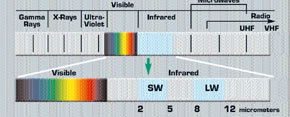 Thermography
is the leading non-intrusive, non-invasive and non-destructive
tool available for use in identifying faults within plant,
equipment and buildings. The technique is invaluable in being
able to identify faults before they actually give rise to an
unplanned and costly breakdown.
Thermography
is the leading non-intrusive, non-invasive and non-destructive
tool available for use in identifying faults within plant,
equipment and buildings. The technique is invaluable in being
able to identify faults before they actually give rise to an
unplanned and costly breakdown.
All objects
above -273�C or 0 Kelvin (absolute zero) emit infrared energy.
This energy can be visualised and analysed through the use of
infrared camera systems.
All plant or
equipment in the early or later stages of failure heats up. This
differential in temperature gives the professional thermographer
the ability to identify and investigate further whether a
genuine fault is developing or the temperature rise is a normal
effect.
Thermography
is the use of an infrared imaging and measurement camera to
"see" and "measure " thermal energy emitted from an object.
Thermal, or
infrared energy, is light that is not visible because its
wavelength is too long to be detected by the human eye; it's the
part of the electromagnetic spectrum that we perceive as heat.
Unlike visible light, in the infrared world, everything with a
temperature above absolute zero emits heat. Even very cold
objects, like ice cubes, emit infrared. The higher the object's
temperature, the greater the IR radiation emitted. Infrared
allows us to see what our eyes cannot.
Infrared
thermography cameras produce images of invisible infrared or
"heat" radiation and provide precise non-contact temperature
measurement capabilities.
"Nearly everything gets hot
before it fails, making infrared cameras extremely
cost-effective, valuable diagnostic tools in many diverse
applications."
Also as
industry strives to improve manufacturing efficiencies, manage
energy, improve product quality, and enhance worker safety, new
applications for infrared cameras continually emerge.
Defective connection to contactor
Extremely hot terminal
Faulty
connection to main isolator
Why
use it?
Many
commercial and industrial enterprises demand a high degree of
reliability and availability from their electrical
installations. Traditional forms of preventative maintenance are
very limited in their effectiveness in identifying substandard
electrical contact situations. In addition, preventative
maintenance requires the isolation of electrical equipment,
which is often inconvenient to processes and production.
Infrared Thermography provides a means of condition monitoring
live systems and detecting electrical faults during the early
stages of development through the generation of heat. Early
fault detection provides the time required to plan and carry out
the necessary repairs before catastrophic failure.
Typically, the faults most frequently detected are those
associated with terminations and connections. The mechanical
integrity of electrical connections may be affected in a variety
of ways (i.e. looseness, over-tightening, corrosion etc.).
The prime
difference between Infrared Thermography and cheaper more simply
applied forms of temperature measurement is that temperatures
can be observed and measured without having to make physical
contact.
With thermal imaging cameras, the temperature of surfaces within
the field of view, can be measured, recorded and analysed when
convenient, and for electrical applications, local maintenance
staff can be alerted immediately when potentially dangerous
situations are discovered.
Whilst this sounds straight forward, the considerable benefits
to be derived from its use, depend on selecting the correct
equipment and having the skill and knowledge to use it
effectively. For this, the user will require knowledge of the
operating principles of thermographic equipment, an
understanding of the physics and principles involved and a sound
technical background specific to the intended application.
For IR/T electrical inspection, the prime benefits are:
increased plant availability through a reduction in planned
downtime and a reduction in unplanned downtime through the
detection of faults prior to failure and the avoidance of
consequential damage.
Our thermographers will
identify a fault and propose remedial actions to rectify the
situation before it develops into a costly breakdown.